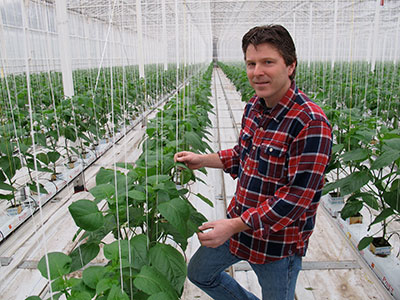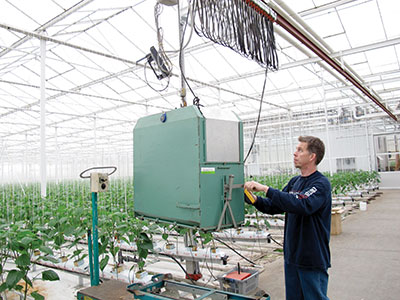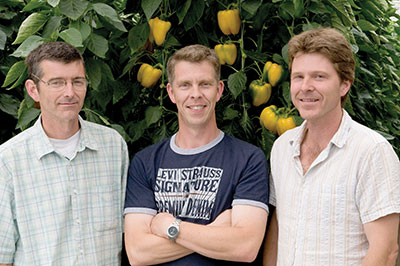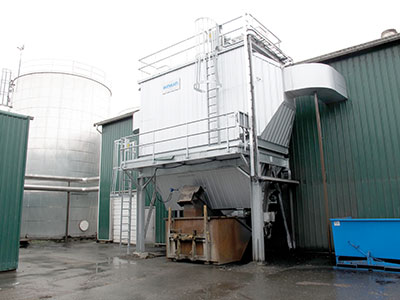
If you want to be successful in the greenhouse industry, a combination
of great employees, premium products, and leading edge technology is
essential.
If you want to be successful in the greenhouse industry, a combination of great employees, premium products, and leading edge technology is essential.
 |
|
| Armand Vander Meulen has taken a leadership role with a number of industry groups. Advertisement
|
Add to the mix owners with a passion for all things “greenhouse,” and you’ve truly got a winning formula.
Vander Meulen Greenhouses of Abbotsford, British Columbia, meets all those criteria. It is owned by Armand Vander Meulen and his wife Petra, who run it with the help of Armand’s brother Peter, who is part owner.
The brothers grew up in agriculture. Their parents, Jake and Ann Vander Meulen, mastered a variety of farming pursuits, including berries and chickens, and later greenhouse vegetables and flowers.
As a teenager, Armand enjoyed helping out in the greenhouse, but wasn’t sure he would make a career of it.
However, it was a visit to Robinson Greenhouses, owned by Sean Robinson, that convinced him his future lay in greenhouse vegetable farming.
“When I saw his facility, and all the progressive and innovative things he was doing in a facility that was about the same size as ours was back then, I knew I could really get into this and run with it.”
Fast-forward to 1996, and Armand started up a new greenhouse at another location. Several years later, they sold the older facilities they had grown up on and moved to their present location.
(Their parents operate a nearby greenhouse flower operation.)
LATEST EXPANSION BRINGS PRODUCTION TO 26 ACRES
In 2012 a new facility at a new location, Bakerview Greenhouses was built. “We now have 26 acres of bell peppers,” Armand explains.
 |
|
| Grower Andre Leendertse, with a harvest bin.
|
The former tomato growers made the switch about a dozen years ago. The reason? Peppers require about half the labour of tomato crops.
“Because we were quite small back then and doing a lot of the work ourselves, it allowed us to operate without having to hire too many employees.”
The family never regretted the decision. “We really enjoy growing peppers.”
Helping them is head grower Andre Leendertse, who has been with them for several years.
There have been five expansions over the years. Their new 11-acre greenhouse is the first of three phases on the new site of what will eventually be a 35-acre facility.
The family’s initial greenhouses were about three metres tall. These were followed by structures of 4.5 and five metres. The new greenhouses are now six metres in height. The taller the greenhouse, the better the growing climate, says Armand.
The first phase, not surprisingly, will be peppers, but Armand is not closing the door to other crops for later phases.
“Those decisions will depend on the market,” Armand explains. “We wouldn’t rule out growing tomatoes again.”
EARLY PEPPER CROPS WERE CHALLENGING
Initially, the move to peppers had some challenges.
There were pest pressures early on, and because peppers weren’t as well established in Canada at that time, there wasn’t the same range of pest management controls as was available for tomatoes and cucumbers.
That’s all changed. The number of minor use registrations for peppers has increased alongside the growth of the pepper sector. “With careful monitoring,” says Armand, “pests are no longer a serious issue.”
Disease pressures have been quite low. “If you maintain a good climate, you can avoid many diseases.”
The company has long appreciated the impact technology has on improved quality, yields and productivity. In addition to talking with other growers, they often visit the Netherlands to view the latest developments. And it isn’t long before those innovations find a home in the Vander Meulen greenhouses.
For example, with their expansion of about four years ago, they installed some raised gutters with the pepper crop. They had had issues before with inconsistent watering with bags on the ground. The raised gutters, however, all but eliminated that problem.
“We were so impressed, we installed raised gutters throughout the rest of the facilty. We immediately saw an increase in production,” along with quality improvement and reduced water usage. “We now have no waste water whatsoever.”
There are a few other pepper growers in the province with raised gutters, but the systems are not yet widespread.
REPLACED PICKING BASKETS WITH BINS FOR GREATER EFFICIENCY
They also replaced picking baskets with bins. They had seen them in the Netherlands and knew of at least one other
grower in the province using them.
 |
|
| Peter Vander Meulen, Andre Leendertse and Armand Vander Meulen. Absent when photo was taken is Armand’s wife, Petra.
|
“There is no lifting from the labour point of view,” Armand explains, “and the product is handled more gently. There is greatly improved efficiency with picking rates because there is much less moving of baskets.”
The system results in at least a 50 per cent improvement in picking efficiency. “We knew we had to go with them,” Armand recalls. “It’s a system that pays for itself very
quickly.”
They also implemented a labour management system. It’s not designed to make employees work faster, but rather to ensure that everyone is working at a comparable level. The system does show if someone is not capable of doing certain jobs, and in that case, they are moved to other jobs.
The system has raised the bar for everyone. “When people saw what someone else was capable of doing,” says Armand, “they all wanted to do it.”
WOOD BOILER SYSTEM HELPS KEEP COSTS UNDER CONTROL
The company also addressed their heating challenge a few years ago with the purchase of a wood boiler system. While the initial capital cost was substantial, operating costs have since been lowered by 60 to 70 per cent. The wood is obtained from mills located within the region, and there’s no shortage of supply.
 |
|
| New technologies ensure growers using wood boiler systems easily meet the most stringent environmental regulations.
|
The boiler is ultra efficient and clean burning.
Cocopeat is used as the growing media, replacing yellow cedar that is more commonly used in the B.C. industry. Yellow cedar is a good growing medium, but it can be inconsistent, says Armand.
“We switched for the uniformity.” Every bag of cocopeat is identical, he notes.
The cocopeat bags are also much lighter and easier to move around the greenhouse.
The Vander Meulens are currently recycling the cocopeat by grinding it together with plant material to spread on farm fields. However, they’ve been looking to develop a commercial compost with the material. It would be completely organic and therefore quite popular with consumers.
Vander Meulen Greenhouses does a lot of trialling for seed companies, with 50 to 100 different trials going on at any time.
The company also has a 15,000-square-foot refrigerated packing facility, capable of serving up to 80 acres of production. They pack for two other growers, in addition to themselves.
It’s unique because it’s a fully cooled and enclosed facility. Packing in a more comfortable climate (13 to 15 C) helps improve shelf life.
Armand has enjoyed serving on a variety of industry boards, including the B.C. Greenhouse Vegetable Research Council in the 1990s. The company was a founding member of the B.C. Greenhouse Growers Association, and Armand served for many years as a director with B.C. Hothouse Foods and with the B.C. Vegetable Marketing Commission.
FAMILY HAS LONG BEEN INVOLVED WITH CHARITABLE FOOD AID GROUP
Vander Meulen Greenhouses has a long association with Fraser Valley Gleaners, a charitable association that uses donations from area farms to prepare soups for Third World communities. Some 11.5 million soup servings were shipped in 2011. The project is near and dear to Armand’s mom, Ann Vander Meulen, who has been a director with the
organization.
“There are a number of greenhouses that are involved,” says Armand. “It’s a great program to support.”
The industry is as challenging as it is rewarding. “There is so much innovative technology being introduced because this is such a competitive industry,” notes Armand. “We compete against the world. You really have to stay on top of anything that will improve quality, yields or cost-savings.”
And, he adds, there is the daily satisfaction in producing a product “that is so healthy for consumers.”
Print this page